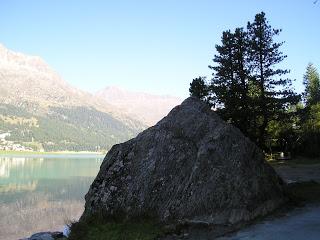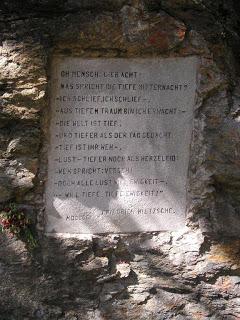I have traveled in Nietzsche’s footsteps for the last 15 years or so. Not only have these travels given me otherwise inaccessible insights into his philosophy and his soul, but I have also experienced aesthetic delights of unparalleled measure. Recently, I have revisited Sils-Maria in the Upper Engadine (Swiss Alps) where Nietzsche had his memorable epiphany. It was in early August of 1881, “6000 feet beyond man and time”, when the thought of Eternal Return suddenly invaded his mind and became pivotal to his philosophy. The hauntingly beautiful scenery has an air of Hades about it, not least because of a large, pyramidal boulder at the edge of Lake Silvaplana. It appears to have been dropped from the skies by Sisyphus, that infernal hero of the absurd. His eternal struggle with this weighty stone can be seen as a metaphor for humanity’s struggle with the pain of existence.

It was by this Sisyphean boulder that Eternal Return was born:
“The greatest weight ― What, if some day or night, a demon were to steal after you into your loneliest loneliness and say to you: ‘This life as you now live it and have lived it, you will have to live once more and innumerable times more; and there will be nothing new in it, but every pain and every joy and every thought and sigh and everything unutterably small or great in your life will have to return to you, all in the same succession and sequence ― even this spider and this moonlight between the trees, and even this moment and myself. The eternal hourglass of existence is turned upside down again and again ― and you with it, speck of dust!’Nietzsche, The Gay Science, IV: 341
―Would you not throw yourself down and gnash your teeth and curse the demon who spoke thus? Or have you once experienced a horrific moment (ungeheuren Augenblick) when you would have answered him: ‘You are a god, and never had I heard anything more divine!’ If this thought were to gain possession of you, it would change you as you are, or perhaps crush you. The question in each and everything, ‘Do you desire this once more and innumerable times more?’, would lie upon your actions as the greatest weight. Or how well disposed you would have to become to yourself and to life to crave nothing more fervently than this ultimate eternal conformation and seal?”
In all, Nietzsche spent eight summers here, walking, thinking and writing. The Nietzsche House in Sils-Maria provides a record of those years full of pain, strife and the loneliest loneliness. After Nietzsche’s death, his loyal friends commemorated his life with an inscription on a rock amidst the woods of the Chastè peninsula, where he frequently walked, contemplating Zarathustra.

Gustav Mahler paid a musical homage to the philosopher he had much admired by incorporating the fragment of “Midnight Song” from Thus Spoke Zarathustra into his third symphony (which accompanies this article as Music Piece of the Month).
